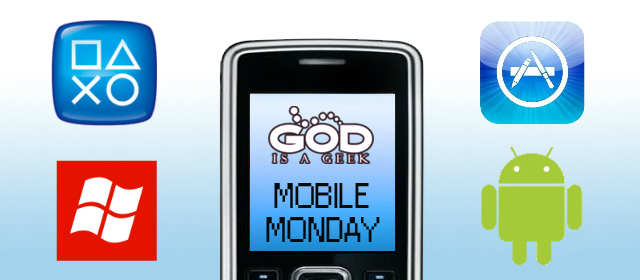You know what day it is? It’s Monday again and that can mean only one thing here at GodisaGeek: It’s time for another edition of Mobile Monday, the article where we take a look at four mobile games and let you know if they’re worth your time and money.
This week we’re taking a look at PuffOut from Maysalward, Punch Quest from Rocketcat and Madgarden, Curiosity – What’s Inside the Cube from 22 Cans and Nana Ninjas from Bad Chunk.
Read on to find the full reviews of each game, but don’t forget to come back next week for more Mobile Monday reviews. While you’re here, if you have played any of the games listed, or even just want to come back once you’ve had a go to let us know how you got on, we’d love to hear from you in the comment box at the bottom of the page.
Titles are available on iPhone and iPad unless specifically stated otherwise. If you like what you read, click the small black “App Store” button to load iTunes up and purchase the title!
![]() PUFFOUT:
PUFFOUT:
Every so often we come across a game on the iOS App Store that normally we shouldn’t want to play. Maybe the art style isn’t all that great or, on paper at least, the gameplay mechanic feels outdated and a little pointless. However, it’s these games, the unexpected ones, that have a tendency to surprise us. Not because the previously assumed shallow gameplay is uncharacteristically deep, but just because we can’t stop ourselves playing them despite every logical part of our brain telling us that we shouldn’t be enjoying it this much. PuffOut, developed by Maysalward, is exactly one of these games.
The gameplay in PuffOut simply asks the player to do one thing: Survive as long as they can in a world that’s constantly getting more and more dangerous. You play as a puffer fish, attempting to avoid all of the obstacles that are put in their way. These objects that you’re supposed to be avoiding will start moving faster and faster, while also getting more numerous the longer that you survive in the level. It’s that survival instinct that will keep you coming back for more, as you start telling yourself “I can do better”. Just as we did with the massively addictive Super Hexagon a few months back.
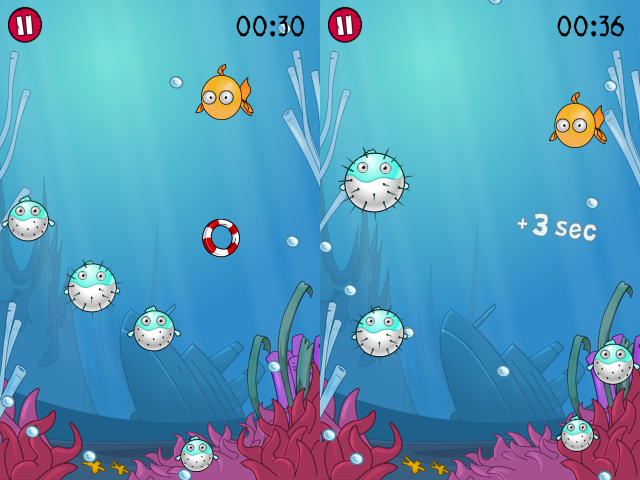
Since the objective of the game is to last as long as you possibly can in the dangerous world of PuffOut, there are items that you can collect that will add time to your score in order to help you achieve greatness. These items take the form of various seafaring equipment such as life rings, ship wheels and the like. Collecting these will add a couple of seconds to your score which might not seem like a lot, but when a mere five seconds separates first and second place on the leaderboards, you’ll soon find yourself glad that you took the risk, and that it paid off. Naturally, collecting these items and adding those precious few seconds to your score will also make it more difficult for other people to beat your score, which is always a good thing.
Controls are the only thing which really let the title down, but it’s more of a problem with the platform rather than the game. In order to move your character around the screen you’re asked to place your finger on them and move your finger around on the screen. While this is a fine control method in terms of ease of use, and it is an intuitive method of controlling the game, it does cause the problem that you can’t really see what you’re doing as your finger is covering up the main character and any threats that might be in their immediate vicinity. This fact alone means that, unfortunately, it’s almost impossible to get a decent score on any of the smaller iOS devices such as the iPhone or iPod Touch. The iPad is definitely the way to go, removing any portability that the game may have had.
PuffOut is a decent little game, but if you’ve only got one of the smaller iOS devices available to play it on then you might find it an exercise in frustration. The control method, while intuitive, is the title’s main downfall. The visuals are passable and the gameplay is enjoyable but it’s a game that lives or dies on whether you come back for repeat plays and if you’re getting frustrates each time you put the game on, that’s just something you’re not going to be doing. 

![]() PUNCH QUEST:
PUNCH QUEST:
Sometimes, an iOS game can surprise us. Not because it’s that original, or even because it’s anything particularly special, but they’re just games that capture the hearts and minds of the people playing them. Punch Quest, developed by Rocketcat and Madgarden, is one of those games. It’s a running game, tasking the player with going from left to right, and that’s a type of game that we’ve seen plenty of times before. So what is it that makes Punch Quest so special?
The further the player manages to run, the more points they’ll have racked up when they finally do succumb to the plethora of enemies that are trying to take them down. In order to get past these enemies, the player is given two attack buttons, one that’s just a simple punch, punching out in front of you, and the other is a punch into the air (which also doubles as a jump button). With these two buttons combined, quick reflexes and a persistent state of mind, you might just be able to scramble your way to the tip of that leaderboard.
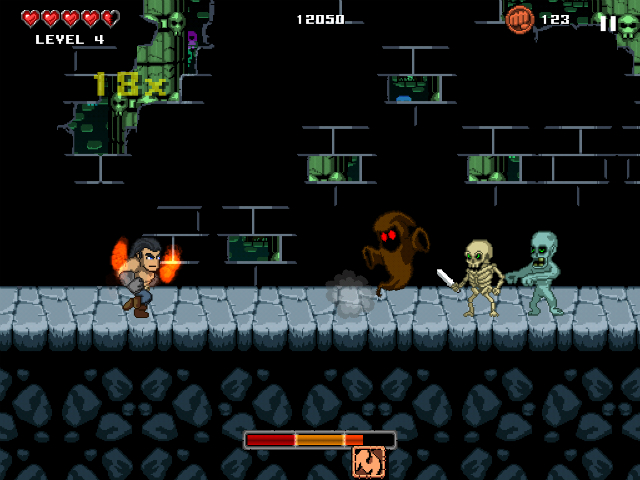
An addition which helps to set Punch Quest apart from its competition in the genre is the levelling mechanic. This mechanic is a subtle one, you won’t find yourself having to equip items or assign skill points, but the further you get into your run, the higher level you’ll become which, in turn, increases how effective you are at doing what you do best in Punch Quest; punching things square in the face. You don’t even have to pay attention to the levelling bar if you don’t want to either, although a quick glance into the top left corner of the screen to the experience bar is always a good indication as to how far into the level you are.
As we’ve come to expect from these types of games, all of the running aspects are performed automatically. You can’t slow down or speed up the main character, he’s out for a run and you’re just along for the ride. The only thing you can do is use the previously mentioned punch and jump/air punch buttons, which are located at the bottom left and right of your iOS device. While playing Punch Quest I found that the game was a little bit cumbersome when playing on the iPad, especially the first generation one as it’s a little bit heavier than all of the models that came after it. It would probably be a much more enjoyable experience on a smaller iOS device, or even one of the lighter iPad models, but if the first generation iPad is your only option then it’s not a bad experience; I would just rest it on something while you’re playing to avoid fatigue.
Punch Quest is just as addictive as all of the other games in this particular genre, however, it has the added benefit of having a levelling mechanic, some gorgeous visuals and much more for the player to do than just jumping and sliding. Punch Quest is a game that you probably won’t find yourself playing for hours at a time, but if you’re looking for a new game to play while you’ve got five minutes spare, there are fewer more enjoyable ways than Punch Quest currently available on the iOS App Store. 

![]() CURIOSITY – WHAT’S INSIDE THE CUBE
CURIOSITY – WHAT’S INSIDE THE CUBE
As gamers we’ve learned to take what veteran game designer Peter Molyneux says with a pinch of salt. So many times he’s promised things that he simply hasn’t delivered on. Earlier this year Molyneux left Lionhead Studios, the company that he founded after those early days at Bullfrog, and formed a brand new studio; 22 Cans. Again, he made wild promises, talking about 22 experiments that would go on to help create his magnum opus. The first of these experiments, Curiosity – What’s Inside the Cube (hereafter just called Curiosity) has been released to mixed feelings, but is that because Mr. Molyneux, once again, promised too much or is the title simply not all it’s cracked up to be?
Curiosity is an internet connected application (it’s hard to call it a game) that asks the player to help the rest of the online community to chip away at a massive block by tapping your finger on it. Each tap removes a single block and the goal is simply to remove all of the blocks on a layer in order to move down to the next. There are a finite number of layers on the cube and only the person who removes the last block, on the last layer, will get to see what’s actually inside the cube. Will that person share their discovery with the world or simply keep it to themselves? That’s the part that 22 Cans is curious about; hence the name.
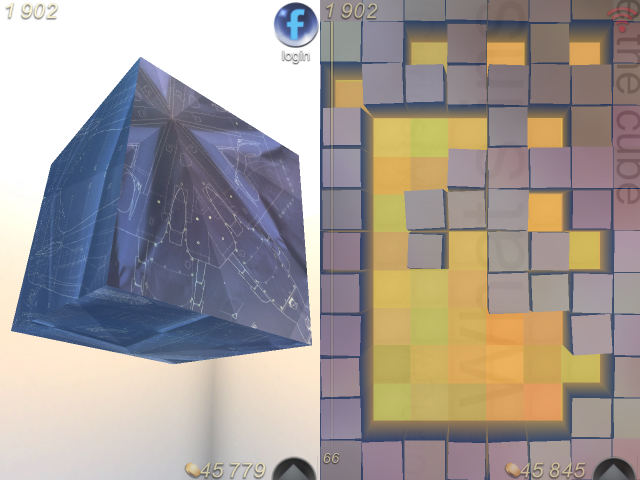
Every tap that the player performs will earn them a gold coin, with the additional ability to combo this gold coin collection if you tap the cubes quickly enough. This serves as the gameplay mechanic that’s supposed to get you wanting to play even more, chipping away at that massive block for even longer periods of time and, for what it’s worth, it does its job admirably but it doesn’t feel like quite enough to keep the player coming back time and again, however, once you’re in the game it does a good job of keeping you there, attempting to beat your own combo. There are also in-app purchases which, when bought, offer the player the chance to destroy more than a single cube with a single tap. These purchases are limited use so if you want to use them, you should do so sparingly as just because you’ve paid real money to play the game faster, there’s no guarantee that means you’re going to ever find out what’s inside the cube.
Curiosity is worth a look, it’s a decent enough idea that’s been executed relatively well. Server issues plagued the application’s early days, and you’re going to have to be connected to the internet all the time in order to play it, but it’s an intriguing concept that is actually rather fun to be a part of when you actually manage to connect to the servers. It’s not a game per se, but as an experiment, and something that could potentially lead to a game (if Molyneux keeps his promises, not holding my breath on that one). 

![]() NANO NINJAS:
NANO NINJAS:
I don’t care what type of game you’re developing, I don’t care what genre it is, I don’t care what the visuals are like or anything like that, if the title of the game has the word “Ninja” in it, or any other variation of the word, you can rest assured that I’m going to sit up and take notice. That’s exactly what happened when Nano Ninjas, developed by Bad Chunk, crossed my Mobile Monday desk. “Ninjas, you say? How potentially interesting!”, and I was right. Nano Ninja is essentially a Plants Vs. Zombies clone but with a few small tweaks that, in some cases, make it a little bit more playable. Also, and I think I’ve already said this, NINJAS!
The gameplay in Nano Ninjas asks the player to protect their village from the ever present threat of the robot horde. These robots take the place of the zombies and move just about as quickly, but that doesn’t mean that you’re going to be able to just sit back and relax as you casually take them out, perhaps in the first few levels but certainly not later on in the game. Once you’ve gotten your bearings with the game, and you’ve grasped the basics of the controls, you’ll be presented with masses of robots, and you’ll have to utilise all of your skill to manage your resources well if you want to take them all down without letting any of them into your village.
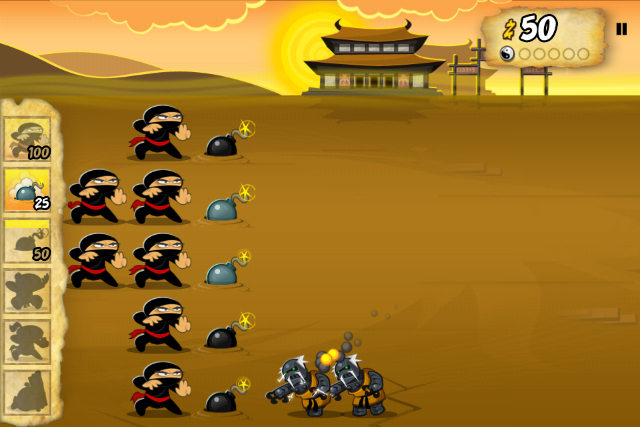
There is actual progression in Nano Ninjas too, so when you’ve finished a battle, as difficult or as easy as it may have been, you’ll always feel like you made a difference. For me, this is an important difference and changes whether or not I come back for more on a regular basis. There’s also little missions for you to perform on each level, such as placing three ninjas on the back row, or blowing up a robot with a specific explosive. Whatever the side mission is, you don’t have to do them but for those people that like to have a little bit more to do in each of the levels, it’s a nice option to have; it’s also nice this is actually an option and not a necessity.
The control method for Nano Ninjas is easy to get to grips with, although when you’re placing ninjas as quickly as you need to in some of the levels, having easy controls is somewhat of a requirement, nothing would turn a player off faster than failing a mission due to shoddy controls. Thankfully, this game doesn’t suffer from that at all. The one thing I would say is that I felt that the icons on the left hand side of the screen, which display your units, are a little small. It never caused a problem but it did make me wish that I was playing on an iPad instead of the iPhone.
While it is strikingly similar to Plants Vs. Zombies, Nano Ninjas is a fantastically fun game in its own right, the progression aspect and the side missions will keep people coming back for more while the main gameplay mechanic is tried and tested and people seem to adore it, so why change what isn’t broken? If you’re looking for a new game that can either be played in 5 to 10 minute stints, or hours at a time, make sure you at least consider Nano Ninjas. NINJAS! 



